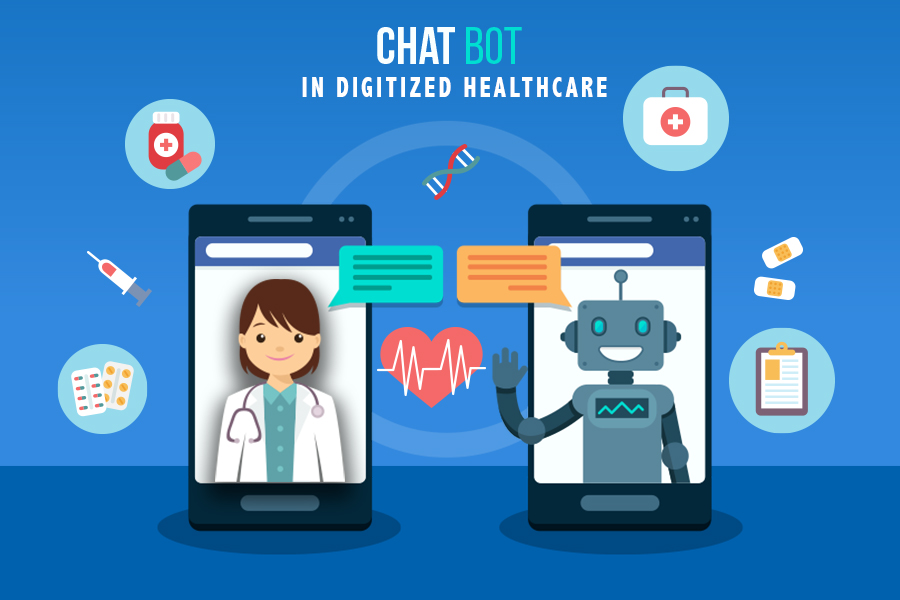
Posted On February 28, 2019
Chatbots in Digitized Healthcare
Definition: According to Joseph, ELIZA – a Chatbot is a computer program for the study of natural language communication between man and machine, The term Chatbot – chat(ter)bot was coined by Michael L. Mauldin. Another simplified version is offered by Shawar and Atwell who define it as – Chatbots are chat applications supported by artificial intelligence whose functions range from answering simple questions to taking part in complex conversations.
Types: Depending on their type, Chatbots can conduct voice and text-based conversations. Chat applications are capable of giving different responses to requests or questions from different users. Older generation Chatbots were not very intelligent, to some preprogramed questions they would give specific, predetermined responses hence making the application redundant and not utilitarian. With the advent of artificial intelligence, however, they stared learning and often assuming the role of human operators in several areas, including some basic communication tasks in education and are now being fast adopted in important areas such as healthcare, induction training and daily task performance in corporate and offices. According to Britz, Chatbots are computer programs capable of conducting conversations similar to those between people. Chatbots are often used in order to automate or optimize a business process. The types of Chatbots range from simple to complex – in the latter case, the aim is to exploit a wide spectrum of artificial intelligence. Simple bots handle basic messages and requests from users. When communicating with users, algorithms give pre-programmed responses to a given input as outputs, and their communication style or language use is not sophisticated or highly differentiated.
Market size: Due to the vast range of applications and the widening of a vista of opportunities that Chatbots offer, the global market for smart virtual personal assistants (SVPA), or Chatbots, is growing exponentially. What was valued at $113 million in 2015, according to Transparency MarketResearch Inc., is expected to reach $994.5 million by 2024.1 Google’s Home and Allo, Apple’s Siri, Microsoft’s Cortana and Amazon’s Alexa are popular examples of smart virtual assistants. An SVPA associated with a particular user can begin to understand the tasks offered by its human counterpart, and can learn on the job as humans do. Platforms like IBM Watson Assistant and Google’s Dialogflow provide open access to NLP tools and technologies and make it accessible for every business to design and train its own Digital Assistant. These two technological giants are a guarantee that these technologies will continue to evolve and continue to impact our everyday lives.
Advantages: Similarly in healthcare industry Chatbots have assumed a pivotal role to play and have numerous advantages to both the patients, doctors and the health institutions. This is since Chatbots are interactive and since most hospitals don’t have a robust relationship with their clients when it comes to sharing information. Clients are left in the lurch while searching the web. However with bots which are user friendly, they get real-time instructions. This has boosted inclusivity, efficiency, and responsiveness. Through conversational healthcare, it is more likeable to patients as they enjoy the individualised proactive experience. More importantly, the ability of Chatbots to create a mono system of records saves the health care tonnes of money and time.
Usage in Healthcare: It helps in scheduling appointments, organise admissions and discharges and also schedule patient consultation needs. Telemedicine also helps to diagnose and treat patients remotely. Some salient uses of Chatbots already in operation are:
Examples:Florence — this Chatbot assistant reminds you to take your medicine and gives you instructions if you have not had your medication. It monitors patient health and can help find specialists and book appointments in the assigned geography.
Your. MD — It replaces the assistant of a General Practitioner, asks about symptoms and puts relevant and adequate queries approved by health professionals to identify a condition probabilistically and then sets up appointments.
Safedrugbot— This messaging app helps doctors take notice of possible side effects of drugs during breastfeeding and helps to keep mothers safe.
SimSensei — Still in its infancy stage, it uses voice and face recognition to mimic a therapist, also interacting with the patient at deeper levels.
Other functionalities that are still under testing and development stage include chronic illness management such as Type 2 Diabetes and mental health management. Although premature these Chatbots can offer comfort and reassurance to the patient until the doctor takes up the case.
Structure: The functioning of Chatbots is based on at least four different structures. The first is natural language processing to make sense of the user’s demands followed by knowledge management to provide an answer. Deep and quick learning capability helps the Chatbot to improve its response to each interaction. Sentiment analysis enables the Chatbot to gauge and asses the user’s frustration in order to take a call whether to transfer them to a human interface immediately. Depending on the sophistication degree of the Chatbot, it will try to anticipate the interaction and provide the user with appropriate choices, or just wait for new commands.
Probable issues: It is by now well established that Chatbots are bringing many advantages in the medical field, such as minimising the cost and increasing efficiency. However, the potential negative side need not be overlooked as well. A lot of attention should be put especially in their functionalities that are computerised. It should therefore not be an objective to substitute doctors with Chatbots, but only be utilised in potentially tasks which carry lesser risk such as reminding patients to take drugs and scheduling meetings for health practitioners. Also, we need to understand that the Chatbot technology is in its infancy stage and security measures are still being established. They can revolutionise how things are done online. However, they can be quite damaging and can lead to cybersecurity issues. Therefore a judicious well tested out system of using Chatbots in healthcare is what is expected to be evolving in times to come.
